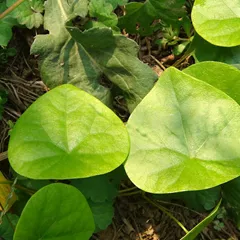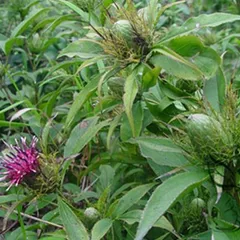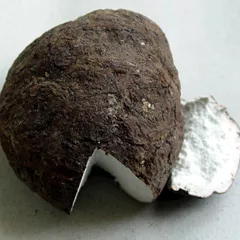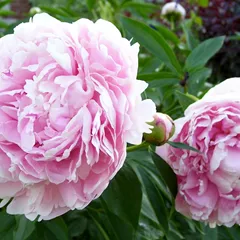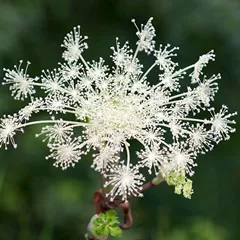Lumbar disc disease according to Chinese Medicine
The information provided here is not a replacement for a doctor. You shouldn't use it for the purpose of self-diagnosing or self-medicating but rather so you can have a more informed discussion with a professional TCM practitioner.
Lumbar disc disease factsheet
Possible causes and remedies:
Symptoms: Edema Sweating Urinary difficulty and one other symptom
Recommended formula: Fang Ji Huang Qi Tang
Exterior Cold invading the Interior
Symptoms: Chills Constipation Abdominal pain and three other symptoms
Recommended formula: Da Huang Fu Zi Tang
In Chinese Medicine, lumbar disc disease can be associated with six so-called "patterns of disharmony". Chinese Medicine sees the body as a system, not a sum of isolated parts. A "pattern" is when the system's harmony is disrupted. It is not equivalent to the Western concept of "disease", as a matter of fact here lumbar disc disease can be caused by six different patterns.
To understand whether someone's lumbar disc disease might be caused by a given pattern, one needs to look for signs and symptoms associated with the pattern beyond what one might typically experience from lumbar disc disease alone. For instance when lumbar disc disease is caused by the pattern Wind-Damp, patients also experience symptoms such as sweating, general sensation of heaviness, edema and urinary difficulty. Similarly, patients with Wind-Damp typically exhibit floating (Fu) pulses as well as a pale tongue with thick white coating.
We've listed below a description of the six patterns associated with lumbar disc disease so that you can start to get an understanding of the various possibilities according to Chinese Medicine.
Once identified, patterns are often treated using herbal formulas. Drinking herbal infusions is the most common remedy in Chinese Medicine, together with acupuncture. Here we detail below five formulas that can help treat the various patterns associated with lumbar disc disease, depending on which pattern fits your profile.
The six "patterns of disharmony" associated with lumbar disc disease
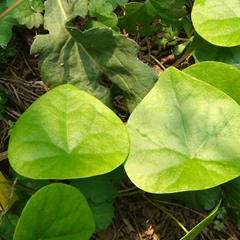
Stephania Roots (Fang Ji) is the key herb for Fang Ji Huang Qi Tang, a formula used for Wind-Damp
Wind-Damp
Pulse type(s): Floating (Fu)
Tongue coating: Thick white coating
Tongue color: Pale
Recommended herbal formula: Fang Ji Huang Qi Tang
Symptoms: Edema Sweating Urinary difficulty General sensation of heaviness
Lumbar disc disease might be due to Wind-Damp if the condition is paired with typical pattern symptoms such as sweating, general sensation of heaviness, edema and urinary difficulty. Similarly, patients with Wind-Damp typically exhibit floating (Fu) pulses as well as a pale tongue with thick white coating.
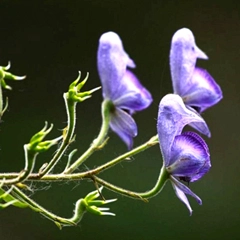
Prepared Aconite (Zhi Fu Zi) is the key herb for Da Huang Fu Zi Tang, a formula used for Exterior Cold invading the Interior
Exterior Cold invading the Interior
Pulse type(s): Tight (Jin), Wiry (Xian)
Tongue coating: Thick white coating
Recommended herbal formula: Da Huang Fu Zi Tang
Symptoms: Chills Constipation Abdominal pain Low-grade fever Hypochondriac pain Cold hands and feet
Lumbar disc disease might be due to Exterior Cold invading the Interior if the condition is paired with typical pattern symptoms such as abdominal pain, constipation, hypochondriac pain and chills. Similarly, patients with Exterior Cold invading the Interior typically exhibit tight (Jin) or wiry (Xian) pulses as well as a tongue with thick white coating.
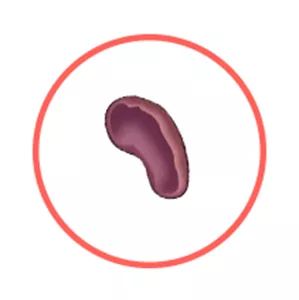
The Spleen is a so-called "Zang" Organ. Learn more about the Spleen in Chinese Medicine
Spleen or Kidney Yang Deficiency
Pulse type(s): Deep (Chen), Fine (Xi)
Tongue color: Pale
Tongue shape: Swollen, Tooth-marked
Recommended herbal formula: Zhen Wu Tang
Symptoms: Edema Coughing Vomiting Dizziness Loose stools Palpitations Urinary difficulty Heavy sensation in the head Abdominal pain that worsens with cold Deep aching and heaviness in the extremities
Lumbar disc disease might be due to Spleen or Kidney Yang Deficiency if the condition is paired with typical pattern symptoms such as abdominal pain that worsens with cold, urinary difficulty, deep aching and heaviness in the extremities and dizziness. Similarly, patients with Spleen or Kidney Yang Deficiency typically exhibit deep (Chen) or fine (Xi) pulses as well as a pale tongue.

The Spleen is a so-called "Zang" Organ. Learn more about the Spleen in Chinese Medicine
Spleen Yang Deficiency
Pulse type(s): Deep (Chen), Slow (Chi), Weak (Ruo)
Tongue color: Pale
Recommended herbal formulas: Zhen Wu Tang Bu Zhong Yi Qi Tang, Yi Huang Tang, Huang Tu Tang, Zhen Wu Tang
Symptoms: Gas Edema Chills Fatigue Bloating Lassitude Cold limbs Weak Limbs Loose stools Poor appetite Pale complexion Feeling of cold Vagina discharge Sallow complexion Desire to lie down curled up Undigested food in the stools Slight abdominal distension after eating Abdominal pain and distension relieved by pressure and warmth
Generally speaking, Spleen Yang Deficiency often develops from Spleen Qi Deficiency, but it is more extensive and severe. The common manifestations are these related to digestive functions such as loose stools, poor appetite, slight abdominal distension and pain after eating, gas and bloating. Since the Spleen fails to transport the Food Qi to the body, patients also suffer from general fatigue, lassitude, weak limbs, pale tongue and face. Patients prefers to lie down.
On top of above, the Yang Deficiency also brings in additional Cold symptoms, such as a cold feeling and cold limbs. It is because Spleen Yang fails to warm the body and Organs. Therefore, the body metabolism get slower and some food are not digested properly and passes directly into the stools.
Since the Spleen fails to perform the function of transforming and transporting fluids, the circulation of Body Fluids is disturbed, causing symptoms such as Oedema, vaginal discharge and Lung mucus. The Yang Deficiency pattern is even more likely to form Dampness and Phlegm.

Prepared Aconite (Zhi Fu Zi) is the key herb for Fu Zi Tang, a formula used for Yang Deficiency with Cold-Damp
Yang Deficiency with Cold-Damp
Pulse type(s): Choppy (Se), Deep (Chen), Minute (Wei), Slow (Chi)
Tongue coating: Thin white coating
Recommended herbal formula: Fu Zi Tang
Symptoms: No thirst Cold extremities Generalized body pain Aching bones and joints Aversion to cold - especially at the back
Lumbar disc disease might be due to Yang Deficiency with Cold-Damp if the condition is paired with typical pattern symptoms such as generalized body pain, aching bones and joints, cold extremities and no thirst. Similarly, patients with Yang Deficiency with Cold-Damp typically exhibit choppy (Se), deep (Chen), minute (Wei) or slow (Chi) pulses as well as a tongue with thin white coating.

The Kidneys is a so-called "Zang" Organ. Learn more about the Kidneys in Chinese Medicine
Painful Obstruction with Liver and Kidney Deficiency
Pulse type(s): Fine (Xi), Slow (Chi), Weak (Ruo)
Tongue coating: Thin white coating
Tongue color: Pale
Recommended herbal formula: Du Huo Ji Sheng Tang
Symptoms: Palpitations Aversion to cold Shortness of breath Attraction to warmth Weakness and stiffness Heavy and painful sensations in the lower back and lower extremities
Lumbar disc disease might be due to Painful Obstruction with Liver and Kidney Deficiency if the condition is paired with typical pattern symptoms such as heavy and painful sensations in the lower back and lower extremities, weakness and stiffness, aversion to cold and attraction to warmth. Similarly, patients with Painful Obstruction with Liver and Kidney Deficiency typically exhibit fine (Xi), slow (Chi) or weak (Ruo) pulses as well as a pale tongue with thin white coating.
Read more about Painful Obstruction with Liver and Kidney Deficiency here
The five herbal formulas that might help with lumbar disc disease



The top herbs in Zhen Wu Tang are Prepared Aconite (Zhi Fu Zi), Atractylodes Rhizomes (Bai Zhu) and Poria-Cocos Mushrooms (Fu Ling)
Zhen Wu Tang
Source date: 220 AD
Number of ingredients: 5 herbs
Key actions: Warms and tonifies the Yang and Qi of the Spleen and Kidneys. Eliminates Dampness.
Why might Zhen Wu Tang help with lumbar disc disease?
Because it is a formula often recommended to help with the patterns Spleen or Kidney Yang Deficiency, Exterior Cold invading the Interior and Spleen Yang Deficiency which are sometimes associated with lumbar disc disease. If any of these patterns look like something you might suffer from, this formula might help (although please seek confirmation with a professional practitioner beforehand).
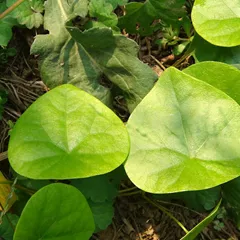
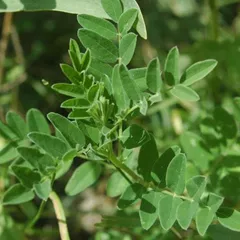

The top herbs in Fang Ji Huang Qi Tang are Stephania Roots (Fang Ji), Milkvetch Roots (Huang Qi) and Atractylodes Rhizomes (Bai Zhu)
Fang Ji Huang Qi Tang
Source date: 220 AD
Number of ingredients: 6 herbs
Key actions: Diuretic, clears Excess fluid and removes edema. Tonifies the Spleen Qi. Calms External Wind.
Why might Fang Ji Huang Qi Tang help with lumbar disc disease?
Because it is a formula often recommended to help treat Wind-Damp, a pattern sometimes associated with lumbar disc disease. If it looks like you might suffer from Wind-Damp, this formula might help (although please seek confirmation with a professional practitioner beforehand).


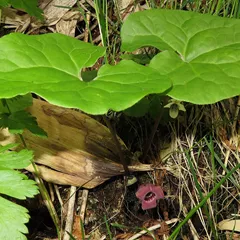
The top herbs in Da Huang Fu Zi Tang are Prepared Aconite (Zhi Fu Zi), Rhubarb (Da Huang) and Wild Ginger (Xi Xin)
Da Huang Fu Zi Tang
Source date: 220 AD
Number of ingredients: 3 herbs
Key actions: Warms the Interior. Disperses Cold. Unblocks the bowels. Alleviates pain.
Why might Da Huang Fu Zi Tang help with lumbar disc disease?
Because it is a formula often recommended to help treat Exterior Cold invading the Interior, a pattern sometimes associated with lumbar disc disease. If it looks like you might suffer from Exterior Cold invading the Interior, this formula might help (although please seek confirmation with a professional practitioner beforehand).



The top herbs in Fu Zi Tang are Prepared Aconite (Zhi Fu Zi), Atractylodes Rhizomes (Bai Zhu) and Poria-Cocos Mushrooms (Fu Ling)
Fu Zi Tang
Source date: 220 AD
Number of ingredients: 5 herbs
Key actions: Warms the Meridians. Assists the Yang. Dispels Cold. Transforms Dampness.
Why might Fu Zi Tang help with lumbar disc disease?
Because it is a formula often recommended to help treat Yang Deficiency with Cold-Damp, a pattern sometimes associated with lumbar disc disease. If it looks like you might suffer from Yang Deficiency with Cold-Damp, this formula might help (although please seek confirmation with a professional practitioner beforehand).
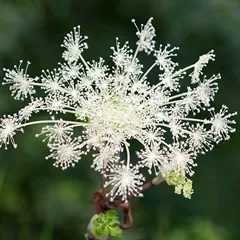

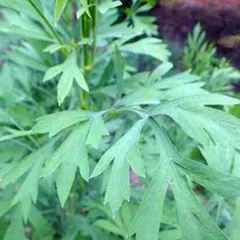
The top herbs in Du Huo Ji Sheng Tang are Pubescent Angelica Roots (Du Huo), Wild Ginger (Xi Xin) and Saposhnikovia Roots (Fang Feng)
Du Huo Ji Sheng Tang
Source date: 650 AD
Number of ingredients: 15 herbs
Key actions: Anti-rheumatic, clears Wind, Cold and Damp Stagnation. Strengthens the function of the Liver and Kidney. Tonifies Qi and Blood.
Why might Du Huo Ji Sheng Tang help with lumbar disc disease?
Because it is a formula often recommended to help treat Painful Obstruction with Liver and Kidney Deficiency, a pattern sometimes associated with lumbar disc disease. If it looks like you might suffer from Painful Obstruction with Liver and Kidney Deficiency, this formula might help (although please seek confirmation with a professional practitioner beforehand).
Symptoms related to lumbar disc disease
Edema Urinary difficulty Chills Loose stools Palpitations Sweating General sensation of heaviness Abdominal pain Constipation Hypochondriac pain


